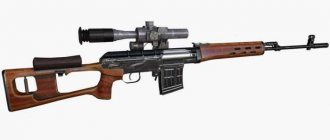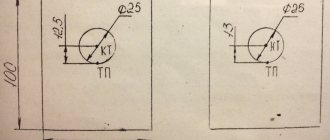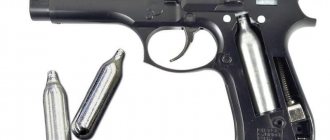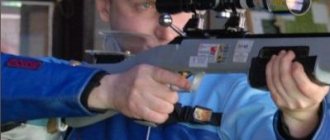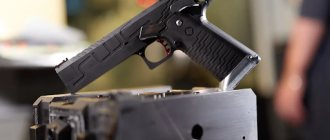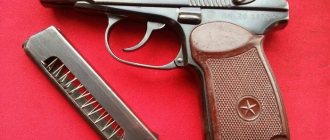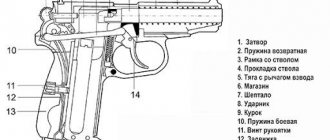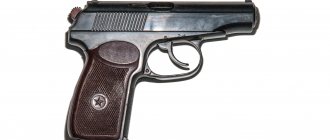8.1. Bringing the PM pistol to normal combat
All pistols must be brought to normal combat. Checking the pistol's engagement is carried out:
- when the pistol arrives at the unit;
- after repairing or replacing parts of the pistol that may affect its operation;
- when abnormal deviations of bullets are detected during shooting.
In a combat situation, each commander is obliged to use every opportunity to periodically check the firing of pistols. Pistol firing is checked
officers or excellent marksmen in the presence of military personnel who are assigned pistols. Senior commanders up to and including the unit commander are required to ensure that the rules for checking the combat of pistols are strictly followed and that they are brought to normal combat. Before checking the combat, pistols are carefully inspected - and any defects found are eliminated. During the inspection, a weapons technician (master) with the necessary tools must be present.
The combat test is carried out in favorable conditions: in clear weather with no wind or in a closed shooting range, or in a section of the shooting range protected from the wind. The pistol combat test is carried out by shooting at 25 m with cartridges of the same batch. Shooting is carried out at a black circle with a diameter of 25 cm, mounted on a shield high 1 m and 0.5 m wide. The aiming point is the middle of the lower edge of the black circle or the center of the circle. The aiming point should be approximately at the height of the shooter's eyes. Along a plumb line above the aiming point, mark (with chalk or colored pencil) the normal position of the middle point of impact, which should be 12.5 cm above the aiming point or coincide with it if the aiming point is the center circle. The marked point is the control point. The pistol firing is checked from a standing position with the hand or from a rest (turf, a bag filled with sawdust) placed on some local object or stand. When shooting from a rest, the hand with the pistol must be suspended and not touch the stop. To check the engagement of the pistol, the sighter fires four shots
, taking careful and uniform aim.
At the end of the shooting, the shield is inspected and the accuracy of the pistol’s firing
and
the position of the midpoint of impact
.
Combat accuracy
a pistol is considered normal if all four holes (at least three, if one of the holes sharply deviates from the rest) fit into a circle (dimension) with a diameter of 15 cm. With satisfactory accuracy of the battle, the commander determines the average point of impact and measures the magnitude of its deviation from the control point using a centimeter ruler.
For ease of measurement, two lines are drawn through the control point (with chalk or colored pencil) - vertical and horizontal. To determine the average point of impact
for four holes, you need to connect any two holes with a straight line and divide the distance between them in half; connect the resulting division point with the third hole and divide the distance between them into three equal parts; connect the division point closest to the first two holes with the fourth hole and divide the distance between them into four equal parts. The point located three divisions from the fourth hole will be the midpoint of impact (Fig. 71). If the holes are symmetrically located, the midpoint of impact can be determined in the following way:
- connect adjacent holes in pairs, connect the midpoints of both straight lines again and divide the resulting line in half; the division point will be the middle point of impact (Fig. 72);
- connect the holes in pairs crosswise with straight lines; the point of intersection of these lines will be the midpoint of the hit (Fig. 73).
Rice.
71. Determination of the average point of impact Based on four holes Fig. 72, 73. Determination of the average point of impact from four symmetrically located holes and determination of the average point of impact from four symmetrically located holes Fig. 74. Determination of the average point of impact using three holes To determine the average point of impact using three holes, two holes must be connected with a straight line; connect the middle of this line with the third hole; divide the new line into three equal parts; the point closest to the first line will be the midpoint of the hit (Fig. 74). Having determined the midpoint of the impact, the commander measures the magnitude of its deviation from the control point. The midpoint of impact should not deviate more than 5 cm from the control point in any direction. If the average point of impact deviates from the control point by more than 5 cm, then the pistol is handed over to the weapons technician (master) for appropriate movement or replacement of the rear sight; the rear sight is replaced with a lower (high) one if the average point of impact is above (below) the control point; The rear sight moves to the left (right) if the midpoint of impact is to the right (left) of the control point. Increasing (decreasing) the height of the rear sight or moving it to the right (left) by 1 mm changes the position of the midpoint of impact in the corresponding direction by 19 cm.
Note. It is prohibited to file down the front sight of the pistol. Bringing the pistol to normal combat is considered complete when the pistol, both in terms of accuracy and the position of the midpoint of impact, satisfies the requirements of normal combat. After bringing the pistol to normal combat, the rear sight is secured with a core; The old mark on the rear sight is cleared, and a new mark is stamped in its place.
Note. It is prohibited to clean the marks on the shutter wall.
Read full summary Material part of small arms
Police weapons | Page 1 | Online library
9 mm Makarov pistol
POLICE WEAPONS
Part 1
7.62 mm Revolver mod. 1895
POLICE WEAPONS. Part 1
9 mm Makarov pistol. 7.62 mm Revolver mod. 1895
Each internal affairs officer must own a service weapon, that is, a weapon in service with the police department.
Possession of a service weapon includes: knowledge of the combat capabilities and design of the weapon, the ability to disassemble and reassemble it in a limited time, clean, inspect, and check the combat.
This manual examines the design and operation of pistols and revolvers in service with the Department of Internal Affairs, their combat properties, the procedure and rules for handling them.
INTRODUCTION.
In terms of combat capabilities, pistols and revolvers are distinguished as a separate type of weapon. This type of weapon has pronounced differences from other types (machine guns, rifles, machine guns, etc.). Pistols and revolvers ensure destruction of manpower only at short distances - up to 50 m (sometimes up to 100 m), have a small mass, usually less than 1 kg, and dimensions that allow you to carry the weapon constantly with you and quickly open fire from it from various positions .
Pistols and revolvers have many common features arising from their purpose, and differ fundamentally only in the design of the mechanisms.
A pistol, in the general sense of the word, is a firearm that is held with one (or two) hands while firing. This definition does not provide for the design features of the weapon, therefore a revolver, in essence, is also a pistol, but uniquely designed. The revolver's charges (cartridges) are located in a rotating drum, and this design feature turned out to be so significant that it gave it the right to an independent name (revolver - from the English revolve - to rotate). A number of innovations, the main one being the rotating drum, made revolvers qualitatively different from their predecessors, pistols. GENERAL CHARACTERISTICS OF REVOLVERS
As mentioned above, a characteristic part of a revolver is a drum with chambers for cartridges. The drum rotates around its axis, and at the same time its chambers are alternately combined with a fixed barrel, acting as a chamber. The drum turns are carried out mechanically using the muscular strength of the shooter. This force is transmitted to the drum through the trigger mechanism. In this case, the shooter’s efforts are mainly spent on compressing the mainspring when cocking the hammer, which is carried out either by pressing a finger on the trigger spoke or on the trigger. This pressure causes the trigger mechanism to work, and it operates the device that turns the drum. Once all the cartridges are used up, the spent cartridges remain in the drum. To load, you need to free the drum from the cartridges, and then re-equip it with cartridges.
Based on the design of the trigger mechanisms, revolvers are divided into simple or single action revolvers, double action revolvers and self-cocking only ones.
Single-action revolvers allow you to fire a shot only after pre-cocking the hammer. In this case, the shooter must pull the trigger back with his finger each time, that is, put it in combat cock. When cocking the hammer, the drum automatically rotates, aligning the chamber with the next cartridge with the barrel. Pulling the trigger releases the hammer and fires the weapon.
Double-action revolvers have become much more widespread, the mechanisms of which, in addition to the method of firing described above, also allow self-cocking shooting, that is, by pressing the trigger without first cocking the hammer. In this case, the trigger moves back, and the drum rotates until it aligns with the barrel of the next chamber. Having reached the rearmost position, the trigger, without being cocked, is released and strikes the cartridge primer. For the next shot, you need to release the hook and press it again. Self-cocking shooting significantly increases the rate of fire, but reduces the accuracy of fire, as it requires the use of more force when pressing the trigger. Double-action revolvers allow the shooter, depending on the situation, to choose one or another type of fire.
Some systems have a trigger mechanism that allows only self-cocking fire. In most cases, the trigger in such systems is hidden inside.
The trigger mechanisms of the vast majority of revolvers have a so-called return trigger. The meaning of this device is that the trigger, after breaking the cartridge primer, moves back somewhat, allowing the drum to rotate freely when loading. In addition, in the lowered state, the trigger, which has a return device, does not touch the cartridge primer with its striker and guarantees against firing a shot in the event that an accidental blow is applied to the trigger from behind, since the trigger can only reach its extreme position when the trigger is pressed all the way.
The indisputable advantage of the revolver is the simplicity of its design, and, consequently, reliability in operation. A good revolver - in good working order, properly lubricated - is almost trouble-free in shooting. Almost every thousand shots there is no more than one delay, mainly due to misfire, and the design of the revolver allows you to immediately repeat the trigger by pressing the trigger. It is unlikely that the next cartridge will misfire.
The revolver is also supported by the fact that, as a mechanical weapon, it is not dangerous to use in inexperienced hands.
You can judge the presence of cartridges in the drum by externally examining the revolver, and the cocked hammer is clearly visible right away. In systems with a hidden trigger, where only self-cocking firing is possible, the danger of a shot as a result of accidentally pressing the trigger, for example, in a pocket, is eliminated, since self-cocking firing requires pressing the hook with great force, exceeding the weight of the weapon.
The constant readiness of a revolver to fire is one of its most important qualities. To start shooting from a self-cocking revolver, you do not need to perform any preliminary operations. The ability to almost instantly fire a shot from a revolver just picked up meets one of the main requirements for a weapon of personal self-defense.
A positive quality of revolvers is their unpretentiousness to cartridges. Hence the possibility of using cartridges with black powder, which is much less susceptible to damage than smokeless gunpowder. The possibility of using black powder is also due to the fact that powder gases are used in a revolver only to eject a bullet, do not penetrate the mechanism and do not pollute it.
The disadvantages of revolvers include their less compact shape with a protruding drum and a handle protruding back, almost empty of any mechanisms, and most importantly, a smaller number of charges compared to pistols, reloading time and, as a result, a lower rate of fire.
The last drawback applies to all revolvers, and especially to systems with alternate extraction (ejection) of cartridges (Fig. 1).
Special shields are mounted on the bodies of such revolvers, blocking access to the chambers of the drum from the rear. One of the shields is attached movably, forming a door. When loading the revolver, the door swings back, revealing the entrance to one of the chambers of the drum. A cartridge is inserted into this chamber. The drum is turned by hand, and a cartridge is also inserted into the next chamber. And so on until the drum is full. After this, the door closes - the revolver is loaded. After firing, to remove the cartridges, you need to open the door and, using a special rod - a ramrod, available on the revolver, push them out of the chambers one by one.
